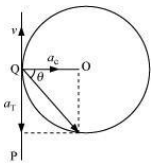4.31 A cyclist is riding with a speed of 27 km/h. As he approaches a circular turn on the road of radius 80 m, he applies brakes and reduces his speed at the constant rate of 0.50 m/s every second. What is the magnitude and direction of the net acceleration of the cyclist on the circular turn?
Speed of the cyclist,
Radius of the circular turn, r = 80 m
Centripetal acceleration is given as:
The situation is shown in the given figure:

Suppose the cyclist begins cycling from point P and moves toward point Q. At point Q, he applies the breaks and decelerates the speed of the bicycle by 0.5 m/s2 .
This acceleration is along the tangent at Q and opposite to the direction of the motion of the cyclist.
Since the angle between is 90°, the resultant acceleration a is given by:
Where is the angle of the resultant with the direction of velocity

© 2025 GoodEd Technologies Pvt. Ltd.